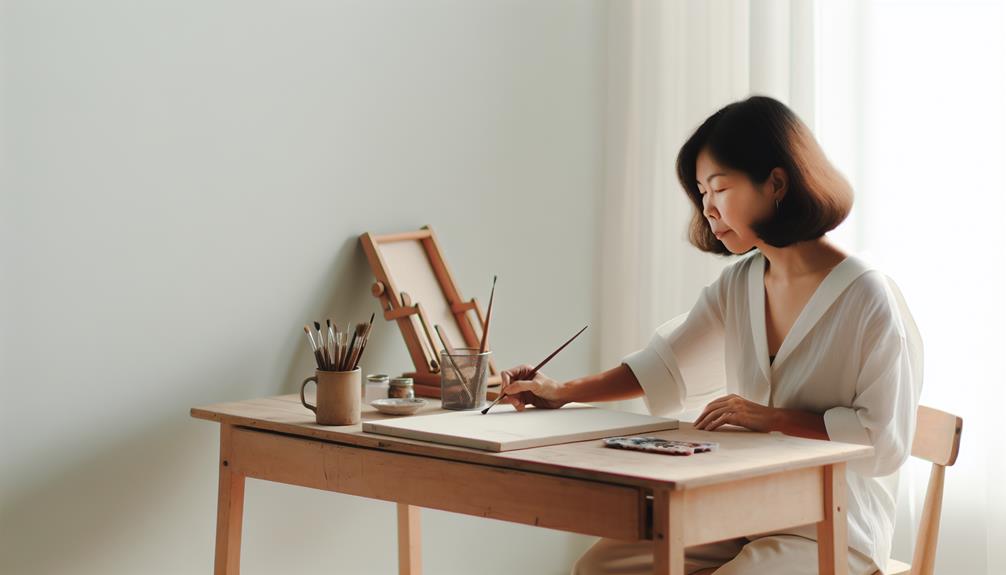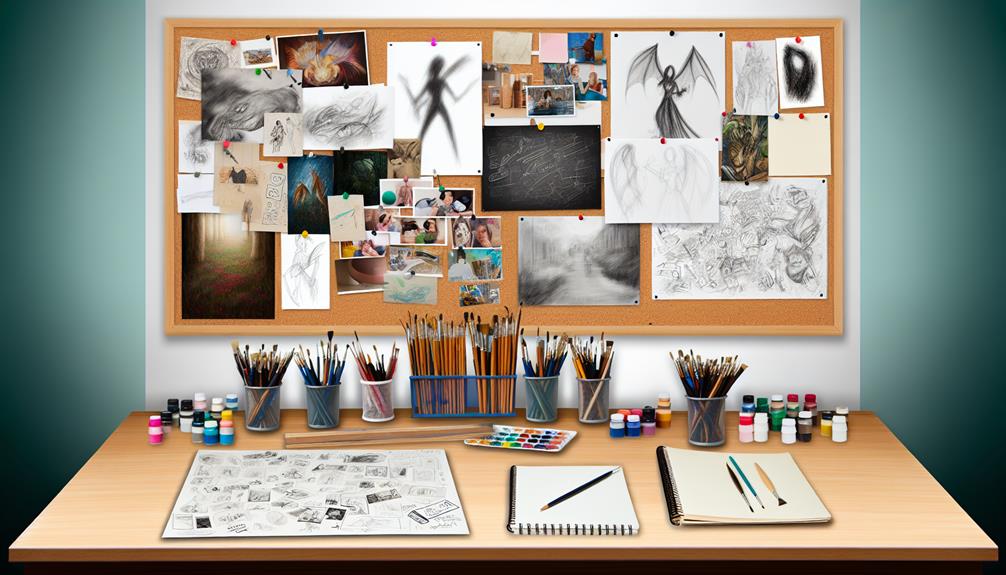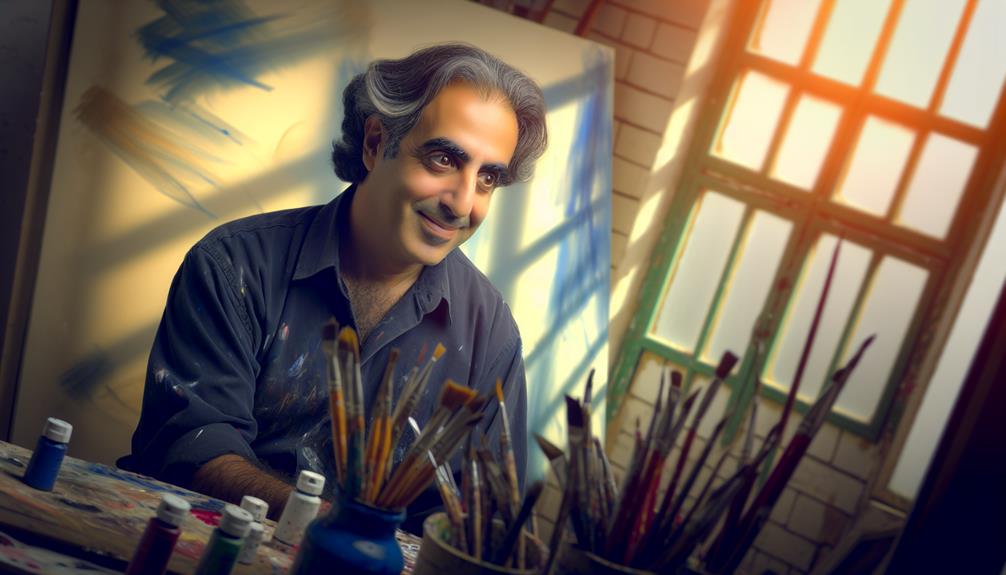So, you've been searching for ways to enhance your creative journey and tap into your full potential. You might have explored various methods, but have you considered the concept of Lean Bliss? This innovative approach challenges traditional notions of creativity and offers a fresh perspective on integrating your passions into a successful and fulfilling creative career. It's time to discover how Lean Bliss can revolutionize your approach to artistic expression and inspire you to achieve new heights in your creative endeavors.
Key Takeaways
- Lean principles prioritize joy and satisfaction in the creative process.
- Eliminating waste by focusing on a dominant writing genre and minimizing exploration of unrelated genres.
- Creating flow in artistic expression through the use of leading lines, repetition, and rhythm.
- Nurturing the creative zone by embracing cross-pollination between genres and prioritizing creative expression over market niche.
Understanding Lean Principles for Creativity
Embracing Lean principles for creativity allows you to align your true voice with your beliefs and values, guiding you towards authentic and fulfilling artistic expression. Following Lean principles means following your bliss, prioritizing what truly brings you joy and satisfaction. It's about understanding that your creative journey is unique and personal. By focusing on your true north, you stay true to your artistic vision and don't let others' opinions sway you. Lean principles emphasize the importance of listening to your inner compass, paying attention to your feelings, nudges, and gut reactions. This guidance leads you to your creative incubation, where your ideas can flourish and evolve.
As a writer, it's essential to let real-life mysteries inspire your fictional ones. Lean principles encourage you to infuse your work with surprise and a compelling ending, making your stories engaging and memorable. Additionally, Lean principles in creativity highlight the significance of balancing artistic vision with audience appeal. It's about finding the intersection between your creative expression and the market niche. This balance ensures that your work stays true to your artistic integrity while also resonating with your audience.
Eliminating Waste in Your Creative Process
To optimize your creative process, identifying and focusing on your dominant writing genre can be a valuable step in eliminating waste and streamlining your efforts. By honing in on the type of writing where your strengths and passions lie, you can minimize time spent exploring unrelated genres and instead channel that energy into your creative expression. Here are three key ways to eliminate waste in your creative process:
- Focus on Your Strengths: Concentrate on the writing genre that resonates with you the most. By doing so, you can eliminate the time and effort spent on experimenting with genres that don't align with your strengths, allowing you to delve deeper into your chosen area of creative expression.
- Embrace Cross-Pollination: While it's essential to focus on your dominant genre, allowing for some cross-pollination can also be beneficial. Exploring connections between different genres can spark new ideas and inspiration, enriching your creative process without straying too far from your core strengths.
- Balance Personal Joy and Practical Considerations: Eliminating waste in your creative process involves finding a balance between pursuing personal joy and considering practical aspects. It's important to prioritize creative expression over conforming to a market niche, ensuring that your work remains authentic and true to your artistic vision while still being mindful of practical considerations such as audience engagement and marketability.
Creating Flow in Artistic Expression

Now, let's talk about creating flow in your artistic expression. When you're in the flow, everything seems to come together effortlessly, and you enter that magical creative zone where inspiration flows freely. This state of flow can significantly boost your artistic inspiration and productivity.
Flow in Art
Achieving flow in artistic expression involves skillfully incorporating visual elements to guide the viewer's gaze and evoke a sense of harmony and movement within the artwork. To create flow in art, consider using techniques such as leading lines, repetition, and rhythm, which can help establish a seamless visual journey for the viewer. This can evoke feelings of energy, tranquility, or dynamism, enhancing the overall impact of the piece. Additionally, carefully considering the placement of elements, the use of color and texture, and the overall composition can help achieve a sense of visual unity, contributing to the flow within the artwork. Understanding the concept of flow in art can aid in effectively communicating your intended message and creating a more engaging and immersive experience for your audience.
Creative Zone
Incorporating Lean Bliss into your creative process can facilitate the seamless flow of artistic expression, enhancing your ability to communicate your intended message and engage your audience. To enter your creative zone, start by identifying your dominant writing genre. This awareness will inform your choices and process in creative expression. Consider cross-pollinating genres as well, as this can spark inspiration and innovation in your artistic expression, leading to the generation of new ideas. Nature can also play a crucial role in activating your inner compass and guiding you to your creative incubation. Embracing multi-passionate creativity can further enhance your creative zone, leading to a more fulfilling and meaningful artistic life. By prioritizing creative expression over market niche, you can stay true to your artistic vision and uniqueness, ensuring that your work resonates deeply with your audience.
Inspiration Boost
To enhance your artistic flow and inspiration, consider incorporating sensory experiences and emotions into your creative process. By immersing yourself in sensory stimuli such as nature, music, or art, you can ignite your imagination and deepen your connection to your work. Additionally, tapping into your emotions and innermost feelings can provide a wellspring of inspiration, allowing you to infuse your art with authenticity and depth. Furthermore, seeking out experiences that evoke strong emotions or resonate with you on a personal level can fuel your creative fire and propel you into a state of flow. Embracing these strategies can lead to an inspiration boost, propelling your artistic expression to new heights and fostering a profound connection between you and your audience.
Continuous Improvement for Creative Growth

You can achieve continuous improvement in your creative growth by embracing unconventional ideas and experimenting with new approaches. Embracing unconventional ideas can open up new possibilities for your artistic expression and push you to think outside the box. By continually experimenting and challenging traditional norms, you can foster growth and innovation in your creative endeavors.
Growth Through Experimentation
Challenging yourself to consistently experiment with new creative approaches and techniques is essential for continuous improvement and growth as an artist. Embracing experimentation in your creative process can lead to significant growth and expansion of your skills. Here's how to achieve growth through experimentation:
- Embrace failure as part of the creative journey, as it is essential for learning and evolving as an artist.
- Seek feedback and actively incorporate it into your work to lead to breakthroughs and refinement in your creative expression.
- Continuously challenge yourself to push beyond your comfort zone, as it can lead to transformative growth and innovation in your creative endeavors.
Embracing Unconventional Ideas
As you continue to explore growth through experimentation, embracing unconventional ideas becomes a catalyst for continuous improvement and creative growth. Embracing unconventional ideas involves breaking away from the norm and being bold in your approach to creative expression and inspiration. By exploring the cross-pollination of genres and ideas, you can spark new levels of creativity and discover unique outcomes that set you apart. It's essential to prioritize creative expression over fitting into a market niche, finding the right balance between commercial viability and artistic fulfillment. Being true to yourself and embracing unconventional ideas can lead to a more meaningful and fulfilling creative journey. So, don't be afraid to take risks and venture into uncharted territory, as it can pave the way for exciting new possibilities and growth in your creative pursuits.
Nurturing Innovative Thinking Through Lean Bliss
Nurturing innovative thinking through Lean Bliss involves embracing your dominant writing genre and allowing it to guide your creative process, fostering a deeper connection to your unique artistic voice. This approach encourages you to delve into your preferred writing style, be it poetry, fiction, or non-fiction, and explore how it shapes your innovative thinking and creative expression.
To nurture innovative thinking through Lean Bliss, consider the following:
- Embrace Your Dominant Writing Genre: Rather than feeling limited by your chosen genre, Lean Bliss encourages you to see it as a source of strength. Embracing your dominant writing genre allows you to tap into your natural inclinations and draw inspiration from its conventions and possibilities.
- Integrate Multiple Passions: Lean Bliss celebrates the integration of multiple passions and interests, recognizing that they can enrich your creative expression and innovative thinking. Instead of compartmentalizing different pursuits, explore how they can intersect and influence your artistic endeavors.
- Prioritize Artistic Joy: In the pursuit of nurturing innovative thinking, Lean Bliss emphasizes the importance of prioritizing artistic joy over market demands. By focusing on creative expression and staying true to your unique voice, you can cultivate a mindset that fuels innovative thinking and authentic creativity.
Finding Joy in the Journey of Artistic Expression

Embracing the multifaceted nature of artistic expression can lead to a more fulfilling and enriching creative journey. Finding joy in the journey of artistic expression is about acknowledging the depth and breadth of your creative passions. It's about allowing yourself to explore different creative outlets and embracing the unique ways in which your creativity manifests. By doing so, you open yourself up to a world of possibilities and experiences that can bring immense joy and satisfaction.
When you find joy in the journey of artistic expression, you're not solely focused on the end product or outcome. Instead, you revel in the process itself—the moments of inspiration, the trial and error, the breakthroughs, and even the challenges. Every step of the creative journey becomes an opportunity for growth and self-discovery, allowing you to fully immerse yourself in the experience of bringing your artistic visions to life.
Moreover, finding joy in the journey of artistic expression means aligning your creative endeavors with your core beliefs and values. It involves tapping into your inner compass, paying attention to your intuition, emotions, and instincts as you navigate the creative process. This alignment brings a sense of purpose and fulfillment, infusing your artistic expression with deeper meaning and significance.
Ultimately, finding joy in the journey of artistic expression is about embracing the inherent richness of creativity and allowing it to permeate every aspect of your life. It's a mindset that celebrates the process, honors your creative authenticity, and finds delight in the boundless possibilities of artistic expression.
Frequently Asked Questions
How Can Lean Principles Be Applied to Non-Traditional Creative Fields, Such as Music or Dance?
When applying lean principles in music, you can streamline your creative process by prioritizing tasks and minimizing waste. By focusing on the essential elements of your music production, you can improve efficiency and quality. In dance, lean principles can help you optimize choreography and rehearsals, ensuring that every movement contributes meaningfully to the performance. Embracing lean principles in these creative fields can enhance productivity and artistic expression.
Can You Provide Examples of Specific Types of Waste That Artists Should Look Out for in Their Creative Process?
When you're creating, it's important to identify distractions that can slow you down, like overthinking or perfectionism. Streamlining your processes can help you avoid wasting time on unnecessary revisions or second-guessing. By focusing on the core of your artistic vision and being mindful of where your energy is going, you can minimize waste and maximize your creative output. This approach can lead to more efficient and inspired artistic work.
What Are Some Strategies for Maintaining a State of Flow in Artistic Expression, Especially When Facing Creative Blocks?
When facing creative blocks, maintaining focus is crucial for artistic expression. One strategy is to set a specific time each day for creative work, like John, a painter who dedicates his mornings to painting. Overcoming resistance can involve taking breaks, trying new techniques, or seeking inspiration from other art forms. Remember that flow often comes from persistence and experimentation.
How Can Artists Measure Their Progress and Growth in a Way That Aligns With the Principles of Continuous Improvement?
To measure your progress and artistic development, set specific goals for your creative growth. Track your accomplishments, like finishing a project or learning a new skill. Reflect on your work regularly to see how you've improved. Seek feedback from peers and mentors to help you identify areas for continuous improvement. Embrace the journey of creative expression and use it as a guide for measuring your growth.
Are There Specific Techniques or Exercises That Can Help Artists Embrace a Mindset of Innovative Thinking and Problem-Solving?
When it comes to mindset exercises and innovative thinking techniques, it's essential for artists to embrace an innovation mindset. Creative problem solving involves exploring new perspectives and approaches. To foster innovative thinking, you can experiment with brainstorming sessions, mind mapping, or even engaging in activities outside your creative field. Embracing an innovation mindset means being open to uncertainty and pushing boundaries, which can lead to breakthroughs in your artistic expression.
